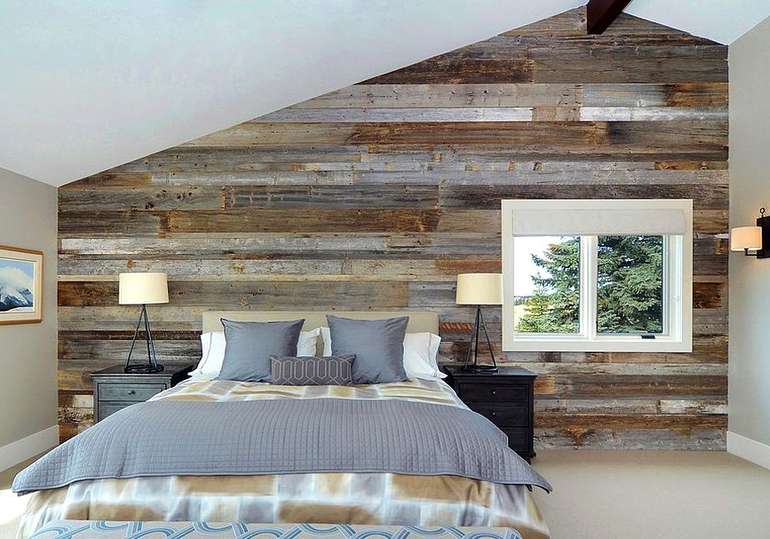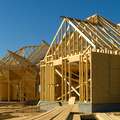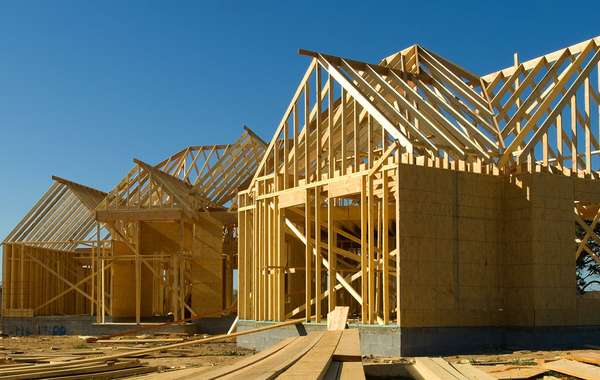Walls in residential homes are almost exclusively finished using gypsum board (either recycled or synthetic) because it is cheap and easy. It is however, not the only option for interior walls, and it has some other competition - especially in areas that may get humidity. We will start with drywall, but also list off a few other options.
Standard gypsum drywall was the alternative
Gypsum is a natural stone found in abundance in the earth. In construction, gypsum is most commonly used as Gyproc panels, or drywall. It’s made by mixing water and aggregates (sand, vermiculite or perlite), and then the gypsum is pressed between two continuously rolling sheets of paper and allowed to harden. Drywall pretty much replaced plaster and lath as the construction industry's "go to" wall finish from around the 1940's.
Drywall is so common because it is cheap and easy to build with, not to mention that it’s also a durable, fire-resistant and fairly moisture-resistant product that also offers an excellent thermal mass for balancing temperatures in homes. On the downside, as drywall is covered in paper and pretty porous, it often promotes mold growth in areas with higher humidity like bathrooms, kitchens and moldy basements, or under windows suffering from condensation problems - which is sub-optimal. When building in areas that may get wet, be certain to choose the improved drywall boards with humidity protection - usually green - or maybe go straight for a 100% recycled plastic wall panel that will still look exactly the same in 1000's of years! (Slightly tongue in cheek here but hey - it could work!)

What is synthetic gypsum board?
Synthetic gypsum board, with up to 96% recycled content (or 'drywall' to use its common street name), is manufactured using waste sulphur dioxide from combustion gases in industrial chimneys. There are many advantages to choosing synthetic drywall; namely, anytime we use recycled and reclaimed raw materials we preserve natural resources and natural habitat destruction. In the case of recycled gypsum board, along with redirecting an endless supply of waste away from landfills, it contributes to reducing acid rain, which is caused primarily by sulphur dioxide from power plants.
The performance and durability of synthetic gypsum panels are the same as those of natural gypsum panels. About 20% of gypsum used in the US is recycled, and there is no reason not to increase that.
Is synthetic gypsum drywall board safe?
Synthetic gypsum typically has lower trace metal content than what is found in residential soil standards because it does not contain extracted gypsum. Some brands of synthetic gypsum wallboard products are certified by the GREENGUARD Environmental Institute as being low in volatile organic compounds (VOCs).
Recently though, some doubts have been raised about the health status of synthetic gypsum panels.
We would suggest you pay close attention to gypsum panels shipped from China as they do not have the same safety standards as Gypsum produced in Canada and the US. In addition to releasing transportation-related greenhouse gases (GHGs), some panels from China release sulphur, which can corrode copper wires and has negative health implications for home occupants. It’s best to buy local when you can, and certainly when there are health implications on the line as well.
Barn boards for interior wall finishing
Reclaimed barn boards can make for beautiful interior walls. It isn’t necessarily something you’ll want on every wall of every home, but as an accent wall it can be beautiful. Like many other woods used for finishing, it isn’t always necessary to apply any coating if they won’t be touched a lot. Boards can be sanded down then wiped well with a wet cloth to remove dust and installed as-is. If you wish to change the look of the board itself, you can apply a natural wood finishing oil to bring out colours.

Tongue and Groove interior wood walls:
Using T & G wood for finishing walls is a nice natural and light finish. Like barn boards, it can be oiled if you like to bring out more color. T & G finishing wood is usually pine, and will yellow as it ages, but this is gradual and not too extreme. To get a better idea of the cost and look of installing wood on walls instead of drywall, see our article comparing prices of wood vs drywall for ceilings

Bricks and masonry interior walls
Using reclaimed bricks or stone as wall finishing will add thermal mass to your home and help balance temperatures. Bricks and unprocessed natural stone should not have or need any finish on it. Hiring a mason to build an interior wall of brick is not the cheapest wall you will ever have but they are of course beautiful, durable, low maintenance, and it can help reduce sound transmission through party walls of attached homes. It isn’t usually hard to find used bricks, see here our page about where to buy and sell used building materials to get some tips on finding stock.
Older semi-detached homes sometimes have brick party walls between homes that are covered in plaster, so you may have a beautiful accent wall just waiting to be unearthed!

Rammed earth wall panels
Another natural interior wall option that brings a lot of thermal mass with it is rammed earth panels. This one you will pay a premium for, but they are a very sustainable and beautiful interior finish. Rammed earth is a building technique using earth mixed with binders to create solid wall panels with the strength of concrete. They are usually built on sites, but there are also some providers of precast rammed earth wall panels.

Plywood wall coverings
Finishing-grade plywood with veneers such as maple or birch can be an excellent - and quick to install - alternative to drywall for wall finishing. Rather than using drywall compound and paper tape for joints, they are usually covered with a thin wood trim. We recently finished the walls of our S1600 LEED Platinum Prefab house with a zero VOC and formaldehyde-free prefinished plywood call UV Wood from Columbia Forest Products. The cost is comparable to other wood wall coverings and drywall as well when you factor the full cost. Plywood panels are of course more expensive than drywall, but finishing joints with wood trim is much quicker than drywall mudding, and panels come pre-finished so there is no primer or painting required.

Hemp wall panels
There is growing demand for hemp building materials, with applications for insulating, soundproofing and finishing. Hemp boards are not structural but they are a solid wall covering. Hemp is a one of the most sustainable alternatives to wood fiber for building materials as well as being non-toxic, so it is great for maintaining healthy indoor air quality.

Cork panels as a drywall alternative
Cork is a renewable resource, harvested from trees without killing them - and if you're into that MCM vibe, it looks groovy on walls instead of drywall. Although it comes from far away (mostly northern Portugal), its carbon footprint from transportation is quite reasonable given that it is light-weight and can be made very thin - so a lot packs into a shipping container. Cork panelling is hypoallergenic, warm to the touch, makes controlling dust & dustmites easy, and if you choose the right cork wall panels and install them with the right products, it doesn't off-gas toxins into our homes either - contributing to better and healthier interior air quality - making it one of the most sensible, affordable and agreeable drywall alternatives. Cork is also really good as a DIY sustainable flooring material.

Lath and plaster walls
Lath and plaster is rarely seen anymore as a form of interior wall finishing. It is extremely labour intensive, and has been entirely replaced by gypsum board drywall for ease and speed in the mainstream construction industry. We are listing it here more for a curiosity and its historical value. Along with being extremely time consuming to do, it is also a fairly high maintenance wall covering. There is no flex to it, and since houses naturally shift, it is quite common for cracks to form. On the upside, homes built with lath and plaster have a lower incidence of mold, as there is no paper surface to wick up any humidity - but insect attack can lead to walls disintegrating before your eyes.

Natural mud finish walls
Natural finished walls with mud and natural earth pigments is another beautiful, healthy, sustainable…if extremely labor intensive… building method. Similar to lath and plaster, it requires a substrate to support the material, whether that is wooden slats, plywood, or another other substance that can support and hold mud in place without sagging while it dries and hardens. It's also a frequent option for straw bale homes.

Now that you know about alternative options to drywall for finishing walls that are healthy, sustainable, formaldehyde-free and zero VOC. Find more interior finishing options that safeguard interior air quality in the pages below and in our Green Building Guide pages.
See here to learn about the benefits of a free Ecohome Network Membership. |





























RE: Using finishing-grade plywood
The article talks about using thin wood trim to cover joints. Can you explain how you did it?
In the photo, it just looks each panel was screwed in nicely in four corners and dark gaps were left between panels.
Thanks -- eric
I see what you mean, in that photo it looks like they left a gap between panels as a feature. Imagine the same thing but trim boards over the joints. If you look at the wood ceiling on the link below you will see what I mean. There are two photos and neither zoooms in well but it should be enough to give you a visual - Off grid LEED Gold home
I can't believe that a site discussing eco homes as so little good to say about lath and plaster. Homes built using this method are some of the most sustainable. The plaster used is lime which is breathable so no damp/ condensation problems and it as no toxins like gypsum. Lime is not rigid like plasterboard or cement so it will move with the house. Houses built using this method are still standing after a hundred years. It is the number one sustainable method to build with even though it is labour intensive.